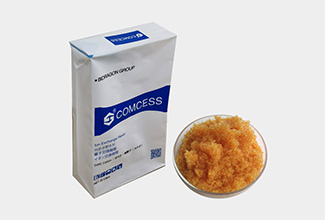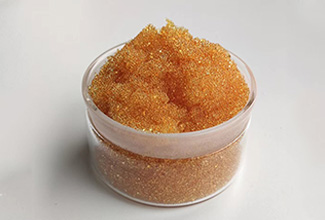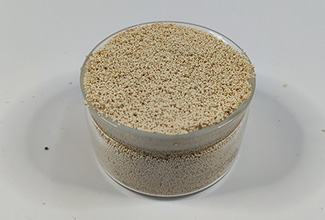Efficient Removal of High Iron Content in Copper Electrolyte: A Green Solution Based on Chelating Resins
This paper addresses the issue of excessive iron content in copper electrolyte systems during hydrometallurgy. Based on actual production data from a copper mine, this paper systematically analyzes the iron distribution characteristics of the electrolyte system and proposes an iron removal process using ion exchange resins. The results demonstrate that the use of chelating resins with specific functional groups can effectively control the electrolyte iron content within the technically specified range of 5-6 g/L, while also meeting process requirements such as no chloride addition and easy regeneration.
1. Process Flow and Iron Distribution Characteristics
1.1 Hydrometallurgical Copper Smelting Process
The study case employed the standard "heap leaching-solvent extraction-electrowinning" process:
Heap leaching: A leachate containing 1.85 g/L Cu, 0.81 g/L Fe²⁺, approximately 22.42 g/L Fe³⁺ (estimated by subtracting Fe²⁺ from total Fe), and 23.23 g/L total Fe was obtained.
Solvent extraction (SX): Produces a lean solution (0.677-0.8 g/L Fe²⁺, 21.91-22.4 g/L total Fe) and a rich electrolyte.
Electrowinning (EW): A circulating electrolyte system containing 35.86-46.84 g/L Cu and 14.24-14.5 g/L total Fe was produced.
1.2 Key Data on Iron Distribution
|
Process Node |
Fe²⁺ (g/L) |
Fe³⁺ (g/L) |
Total Fe (g/L) |
Other Characteristics |
|
Heap Leachate |
0.81 |
22.42 |
23.23 |
pH=1.69, Mn=296 mg/L |
|
SX Barren (Eastern) |
0.8 |
21.11 |
21.91 |
Cu=0.11 g/L |
|
Rich Electrolyte |
2.251 |
12.245 |
14.496 |
H₂SO₄=172.79 g/L |
|
Spent Electrolyte (EW1) |
2.235 |
12.005 |
14.240 |
Co=190 mg/L |
2. Iron Removal Technology Requirements Analysis
2.1 Current Issues
The iron content of the electrolyte system exceeds the standard (14.24-14.5 g/L), reaching 2.4-2.9 times the target value (5-6 g/L). 1500 m³ of circulating electrolyte requires treatment. Valuable metals such as Co (178-200 mg/L) and Mn (8.5-8.77 mg/L) must be retained.
2.2 Technical Requirements
Treatment Accuracy: Reduce total iron from 14.5 g/L to 5-6 g/L.
Selectivity: Prioritize Fe³⁺ removal (approximately 85%), while retaining Cu²⁺, Co²⁺, and others.
Environmental Performance: Avoid introduction of interfering ions such as Cl⁻.
Economical Performance: The resin must have good regeneration performance (≥500 cycles).
3. Ion Exchange Resin Design
3.1 Resin Selection Recommendations: Iminodiacetic acid chelating resins (such as Lewatit) are recommended. TP-260 features:
Fe³⁺ selectivity (KFe/Cu) reaches 10³-10⁴
Wide pH range (0.5-5.0), suitable for acidic electrolyte environments
Regeneration efficiency >98% (using 5-10% H₂SO₄ solution)
Strong anti-fouling ability (tolerant to organic phase carryover)
3.2 Process Parameter Design
|
Parameter |
Set Value |
Theoretical Basis |
|
Operating pH |
1.5-2.0 |
Inhibits Fe3+Fe3+ hydrolysis and optimizes adsorption capacity |
|
Empty Bed Contact Time (EBCT) |
15-20 min |
Ensures efficient mass transfer of Fe3+Fe3+ |
|
Regenerant |
8% H2SO4+0.5%H2SO4+0.5% H2O2H2O2 |
H2O2H2O2 oxidizes residual Fe2+Fe2+ to easily elutable Fe3+Fe3+ |
|
Iron Dynamic Exchange Capacity |
45-50 g Fe3+/LFe3+/L |
Measured value for wet resin |
3.3 Expected Results
Single-stage treatment can reduce iron content to below 6 g/L. Cu loss rate <0.5%, Co loss rate <3%. The resin can be used stably for ≥500 cycles (estimated lifespan of 1.5-2 years). The replacement cycle will be assessed based on actual operating conditions.
4. Technical and Economic Analysis
4.1 Investment Estimation
|
Item |
Specification |
Quantity |
Remarks |
|
Resin Loading |
TP-260, 1.2m³/column |
12m³ |
4 columns in series × 3 trains |
|
Regeneration System |
PE material |
1 set |
Includes metering pumps and oxidant dosing unit |
4.2 Operating Costs
Resin Loss: Approximately 0.8%/year (approximately €15,000/year)
Acid Consumption: 0.6 kg H₂SO₄/kg Fe⁺ removed
Energy Consumption: <5 kWh/m³ electrolyte
5. Conclusion
The use of iminodiacetic acid chelating resin to treat high-iron copper electrolyte offers significant technical and economic advantages. This solution not only stably controls the iron content within the process requirement of 5-6 g/L, but also achieves efficient retention of valuable metals and environmentally friendly resin regeneration, providing a reliable technical solution for similar copper smelters. Pilot trials are recommended to further optimize operating parameters.
-
 C008FG Food Grade ion exchange resinAppearance: Claybank to tan transparent spherical particle.The degree of crosslinking : 8%.Ionic form:Na+
C008FG Food Grade ion exchange resinAppearance: Claybank to tan transparent spherical particle.The degree of crosslinking : 8%.Ionic form:Na+ -
 C010FG Food Grade Drug Purification Exchange ResinAppearance: Claybank to tan transparent spherical particle.The degree of crosslinking : 10%.Ionic form:Na+
C010FG Food Grade Drug Purification Exchange ResinAppearance: Claybank to tan transparent spherical particle.The degree of crosslinking : 10%.Ionic form:Na+ -
 Chelating Resin for Precious Metals RecoveryAppearance: Milky to light yellow opacity spherical beadsIonic form:Na+Volume complete exchange capacity(mmol/ml):≥2.0
Chelating Resin for Precious Metals RecoveryAppearance: Milky to light yellow opacity spherical beadsIonic form:Na+Volume complete exchange capacity(mmol/ml):≥2.0

